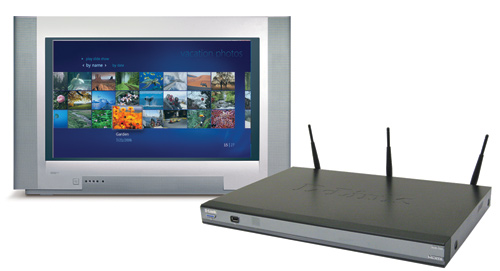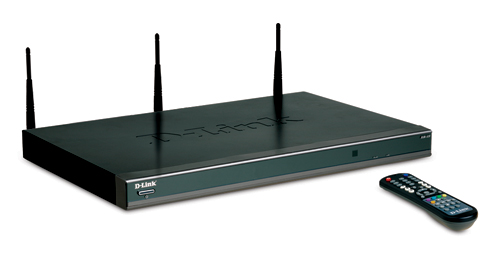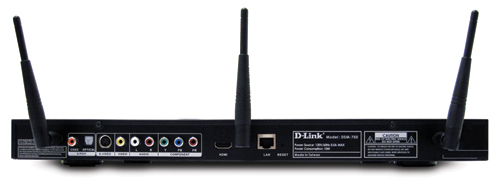A few years ago, Bill Gates decided to leverage his foothold in the world's home offices and annex our living rooms, too. Smart people sat up and took notice, while some scoffed and others, frankly, trembled in fear. I actually don't have a problem connecting anyone's gear in my home theater, as long as it does something worth doing, does something different, does it better than the other guy, and doesn't come with a exorbitant price tag or monthly fee.
Microsoft's TiVo-esque Ultimate TV hardware and service came and went, and Xboxes aside, the company's next big push in this arena was Windows Media Center. At the end of the day, Microsoft is a software company, and this sophisticated home entertainment solution for the PC was precisely that. The Media Center application was introduced specifically with Microsoft's Windows XP Media Center Edition operating system and more recently integrated within Windows Vista Home Premium and Vista Ultimate. Although not absolutely necessary, a special CE-style remote control can be used to operate a Media Center PC.
Interface The Music. And Movies. And…
On the surface, Media Center provides a nimble, intuitive interface that works with the hardware supplied by a well-equipped multimedia computer. Navigation is vaguely reminiscent of the Sony PlayStation 3's XMB interface, as there is just so much content, so many options in so many categories: We scroll up and down through headings for Tasks, Pictures + Video, Music, TV + Movies, Sports and Online Media, all with sub-headings to quickly put the PC's resources to work for us, from scheduling upcoming recordings to grabbing up-to-the-minute scores to syncing to a portable device.

To get the most out of the experience, you'll want things like a TV tuner card (or two, maybe even one NTSC and one ATSC), a DVD burner and a high-capacity hard disk drive. And Media Center does not merely provide simple access to what's inside that whirring box: It can make the different content work together, like a slideshow of our best photos set to our favorite music. Media Center even empowers the acquisition of new content, by recording TV or ripping CDs, or even via that boundless entertainment destination, the Worldwide Web.
Again, Media Center runs on the PC, which tends to be located wherever you need it most, likely a home office. Lots of people have a cable TV hookup in whichever room serves as the office (our house came wired in every room), but who has a computer connected to their TV? There are some fancy ones; quiet, stylish, even horizontal like audio/video components; but they tend to be pricey. So what to do if you want to marry all of your digital media with your big-screen HDTV and the good speakers?
Go The Distance
Media Center Extenders are a handy solution, a class of devices that allow us to stream content from the computer to a set-top box connected to the home theater via a home network. Such devices include the latest models of the aforementioned Xbox, namely the Xbox 360, among that game console's many features, but also dedicated products like the D-Link DSM-750 "MediaLounge." The MediaLounge connects wired or wirelessly, and with its support for Draft-N 2.0 Wi-Fi, supplies bandwidth aplenty even for high-bitrate HD video files.

The device pairs well with D-Link's Xtreme N Gaming Router, the DGL-4500, which I used in conjunction with this review. Although designed to support high-end online gaming--you can customize your network to prioritize and sustain game traffic, to prevent performance hits by someone else hogging bandwidth for a big download--it is a fabulous multipurpose router with exceptional range and readouts of its blazing speeds (showoff!) It also provides Gigabit (1,000 megabits-per-second) ports, and because most wireless devices are on the 2.4 gigahertz band, both the MediaLounge and the Xtreme N Gaming Router are dual-band, operating on either 2.4 or 5 GHz, to avoid interference.
While the MediaLounge does not require Windows Vista or Media Center on your connected PC to stream media to the living room, it is that added level of elegance that we focused on specifically, how a Media Center Extender dispatches content from the computer hub, wirelessly. Connecting the router to my Vista PC, while not simply plug-and-play, was remarkably easy thanks to the proactive nature of Vista, which always seems to want to help via pop-up questions. Patching the MediaLounge into my HDTV via HDMI, like any other home theater component, was a piece of cake.
Into Thin Air
Wirelessly via the router, I was able to configure the MediaLounge to link to my PC by clicking through a series of obvious choices proffered by Windows Media Center. Microsoft; and, for their part, D-Link; have removed a lot of the frustrating, tedious, time-consuming aspects of the setup process, and minutes later I was staring at the friendly, familiar blue menus up on my 50-inch Samsung DLP screen. Because the onscreen interface simply mirrors the Media Center we've already established, additional setup steps such as searching the hard drive for files is not necessary, and we can continue using Media Center as if we never left the keyboard.
Well, almost: The Windows button on the MediaLounge remote brings up the Media Center interface, and the up/down/left/right and OK buttons do wonders to sift through and grab whatever we feel like watching or listening to, be it already on our hard drive or out there in the ether, waiting to be streamed or downloaded. Embedded within Media Center is support for Vongo, CinemaNow and Movielink subscriptions/rentals/purchases, all for a fee. I was intrigued by the Showtime logo I spotted, but it's really just a guide to what happens to be airing on Showtime, and we need to get up and go back the computer to set up this feature with a keyboard and mouse. I was further teased by the offer of free episodes of Arrested Development, but I could not find a way to make them actually play.
In case you haven't checked recently, it turns out that the Internet is not the free-for-all it's cracked up to be. In fact, we seem to be at a sort of crossroads. Who--other than Microsoft, who either quietly sponsored programs like an Alanis Morissette concert or slapped one of the same 3 unskippable commercials before assorted video shorts, over and over--is going to foot the bill for this entertainment? There are only so many free virals I care to watch: They are a fine diversion from work while I'm at the keys, sometimes, but in my home theater I want better than another hit of "Chocolate Rain."
Videophile Video Files?
Which also brings up that other issue of quality; not the four-star, Academy Award-winning sort; rather how our content looks and sounds in the home theater. Sonically, while the digital pass-through to a receiver maintains the full original quality of MP3s, WMAs and their ilk, these are compressed audio files and not DTS 96/24 tracks. Streamed to a good receiver, they can be processed and matrixed out to multiple speakers, which is usually a good thing. But while we might not be able to discern the sweat of the guitarist's fingers on the strings, by this point our ears have been trained to enjoy ripped and downloaded tracks for what they are.

The verdict is not so kind for video. Heavy compression of the get-it-now digital age levies a mighty toll on image quality, and blowing it up to big HDTV size only hurts, never helps. Computer video can look anywhere from passable to washed out, as fine detail is often lost in a crush of blocky pixels. NTSC or ATSC TV recording, made all the more convenient by Media Center's extensive interactive program guide, can yield enjoyable results, assuming a reliable over-the-air signal or a snazzy digital cable hookup. (Despite rays of hope over the years, satellite never learned to get along with the PC.) The MediaLounge device can play back high-definition video in both the Windows Media Video 9 or MPEG-2/MPEG-4 formats, but beyond our own DVR'ing, where is this HD content coming from?
Granted, a lot more people are capturing and watching their home movies in high-def, now that HD camcorders have become de rigueur. Failing that, there are only so many free, downloadable three-minute nature clips I can bear to watch in HD. I don't need undersea marvels to sell me on the benefits of higher resolution, I want movies, long or short, that really entertain. This is a case where the content--more accurately, the content providers--have not quite caught up to the technology. And if you were wondering, you cannot play a DVD on your computer and stream it to the TV.
Turn Ons:
Turn-Offs:
Final Thoughts
The MediaLounge DSM-750 goes beyond streaming your digital content to the home theater, not only removing the need for an actual computer situated next to the TV but by putting full Windows Media Center functionality on your plasma, DLP or LCD. The proactive ease and Swiss Army knife-like convenience of Media Center is undeniable, and the streaming performance of the MediaLounge teamed with the D-Link router was nigh-flawless, I just question whether the quality of the content--what we might have on our hard drive and what we are able to add, today--is ready for prime time.
Where to Buy:
D-Link MediaLounge Media Center Extender DSM-750 Specifications
Package Contents:
Outputs:
Input:
PC requirements for Media Center Extender Mode:
Supported Media Formats:
Audio:
Video:
Photos:
Digital Rights Management (DRM) Support:
Network:
Wireless:
Wired:
MSRP: $329.99
Weight and Dimensions:
Warranty:
Company Information:
D-Link
17595 Mt. Herrmann
Fountain Valley, CA 92708
ph: 800-326-1688
Web site: http://www.dlink.com/
| Overall | |
|---|---|
| Value | |
| Performance | |
| Features/Ergonomics |